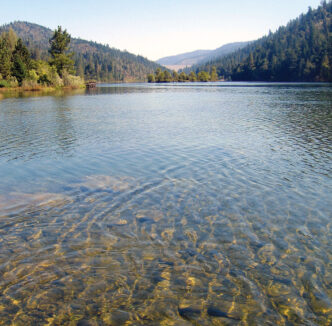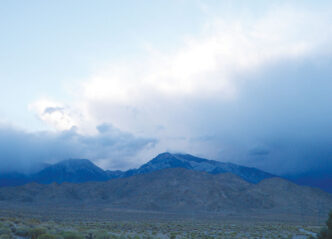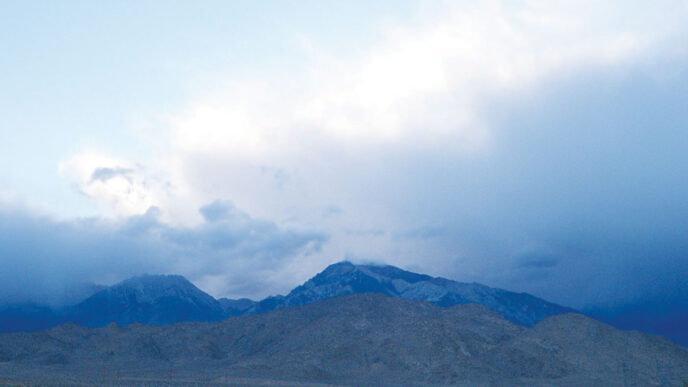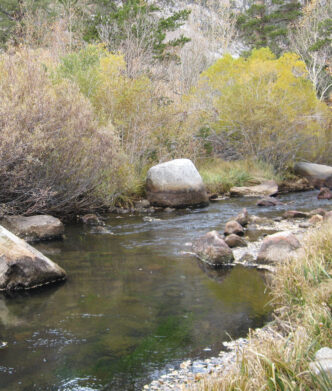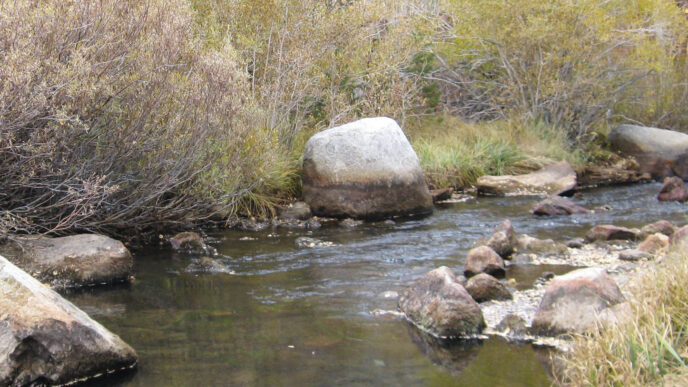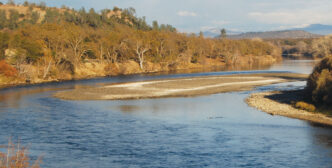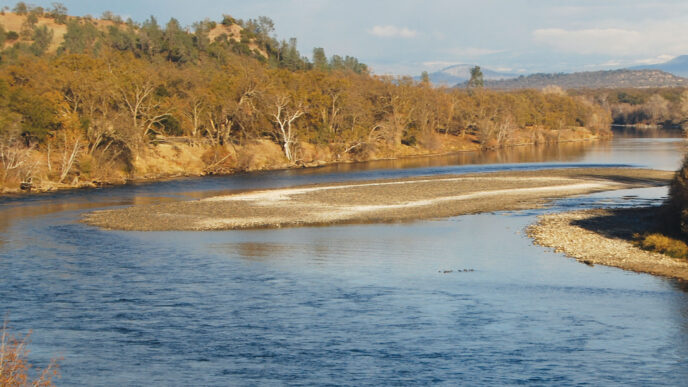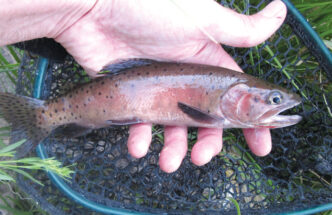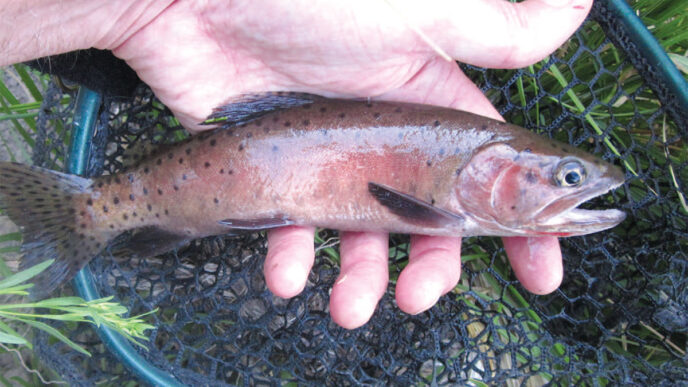Sitting in a boat on Trinity County’s Lewiston Lake and feeling dumb is a specialty of mine. The surroundings make that all but inevitable. There is plenty of very clear water, lots of sky, and the lake is set amid forest-covered hills. Maybe a bald eagle will fly by. Your attention wanders, then an odd sensation of loss creeps into your mind. What’s missing is your strike indicator. You’ve just lost another fish.
Lewiston Lake is a hard place to get skunked, except when it isn’t. The fish run on the large side, lots of robust, 15-to-16inchers, and a few even larger, and even though most of the rainbow trout here come from a hatchery, they seem determined to act like wild fish. The “lake” is actually an afterbay for water from Trinity Dam flowing into the Trinity River. It’s a delightful combination of moving water and still water, and you rarely know in advance what particular fly or technique will win the day. If you’ve never fished Lewiston, here are some things you need to know.
Where to Begin
By far the best way to fish Lewiston Lake is from a boat. Pontoon boats and even float tubes may also be used, but a boat gives you much easier access to more water. Lewiston is like a spring creek in its upper reaches, and more like a lake down below. An electric motor will get you around, but with a gas motor, you are in a much better position to fight the current and go where you want. The lower down on the reservoir you go, the less the current is a factor, but don’t stray too far below the Lakeview Terrace boat launch ramp. There are many more fish toward the upper, shallower end of the reservoir. Don’t forget to bring an anchor.
The two main access areas to the upper lake are the Lakeview Terrace and Pine Cove boat launch ramps. Off of Lakeview Terrace, the water is shallower, and the fish are more selective, so where you go depends on time of year and what kind of fishing you want. In the winter, I prefer Pine Cove, and in the summer, I launch from Lakeview Terrace. The water adjacent to and above Pine Cove has a stronger current. However, even though I tend to think of the water above Pine Cove as good cold-weather water and the below Lakeview Terrace as better in warm weather, this isn’t strictly true. Any of this water can be productive on almost any day. There are also several islands between the two launch ramps that are often worth exploring.
The Winter Season
It can get chilly at Lewiston in the winter, but the fishing can still be good. Layer up as if you’re going skiing, and then add a layer or two for the fact that you won’t be warming yourself through exercise. You might look like a potato sitting in a boat, but the fish don’t care. Gloves are a great idea, and a waterproof outer layer makes sense just in case. Hot coffee or soup tastes mighty good out there.
Depending on the amount of precipitation, there is a very good chance there won’t be as much water moving through the system during the winter. When there is current, try fishing nymphs under a strike indicator in both the current and the seam between the fast and slow water. There are days when the current is hardly even there, so if you imagine the current as a conveyor belt bringing food to the fish, it’s easy to understand why the fish spread out in search of food when the current slows down.
Nevertheless, there are areas that almost always hold fish, regardless of the current. Launch your boat at Pine Cove launch ramp and head just upstream to the island there. Fish the top, inward side (toward Pine Cove), and the bottom of the island. The channel between the island and the far side of the reservoir has rarely been productive for me. Start fishing about 30 feet from the island and work your way closer and closer to the bank. Most days, the fish will hold a little way out from shore, but there are days when they hug the banks. There is also some good water above the island and on up toward Trinity Dam.
Plan on fishing subsurface in the cold. Start by hanging a chironomid nymph about five feet under a small indicator. I like to fish those small yellow-and-orange Corky indicators that you jam on your leader with a toothpick. They float well, are easily seen, and casting them isn’t flirting with tangled-line disaster. Almost any midge nymph will work, as long as it’s in the size-16-to-18 range. Despite the clarity of the water, I’ve never had to use anything smaller than a 4X fluorocarbon tippet during the winter. If you aren’t picking up fish, try moving your nymph closer to or farther away from the indicator and keep moving around until you find fish.
When all else fails and the fish are making you feel like an escapee from a leper colony, try a sinking line and Woolly Bugger or leech pattern. Good patterns to include Beaded Micro Buggers and Krystal Buggers, size 6 to 12. If you are unable to get any hits with these in the top six feet of the water column, chances are the fish are holding deeper. Try a Type III uniform-sinking line. I have a friend who swears by sink-tip lines, but I’ve only sworn at them in still water. I think they cast like you’re trying to use a fly rod to chuck an apple into the water. Experiment with different retrieves, but slow is usually the way to go during cold weather.
I mentioned using sinking lines during the winter because that’s when I’ve used them most. They’re never a bad choice the entire year round, but during the warmer months, there’s no need to fish quite as deep. Intermediate and even floating lines work better during the summer.
The Ides of March
Sometime in March or April, the trout shift from feeding on midges to the main course for the coming warmer months, the Callibaetis mayfly. During this transition, both midges and Callibaetis patterns work equally well, and some anglers do well fishing one of each under strike indicators. Personally, I favor Callibaetis nymphs, because they are easier to see, and I generally don’t fish droppers, because I don’t like to waste time untangling my line. For Callibaetis imitations, you can fish a brown Bird’s Nest or Gold-Ribbed Hare’s Ear with confidence.
When the weather begins to heat up, so does the Callibaetis hatch. The early season Callibaetis mayflies tend to be large, about a size 12. The hatch lasts almost six months, and the bugs get smaller and smaller. By September, the mayflies are running size 16 to 18, and the fish have become much more selective.
Summer Sight Fishing
When the Callibaetis hatch arrives, now you’re in the money. Fishing Lewiston during the summer can be fantastic, but that may or may not mean catching more fish. The weather is generally wonderful, and the angling can be just as good, especially if you like a challenge.
Lewiston Lake has a fishing derby sometime in June, so you might not want to be there when the lake looks like a Los Angeles traffic jam, or fish without a hard hat when gobs of worms and PowerBait are flying through the air.
What I like best about the summer is fishing the shallow flats across from the Lakeview Terrace boat launch ramp. Because the current is slower there and the reservoir is wider, a pontoon boat is a great choice for summer fishing in this area.
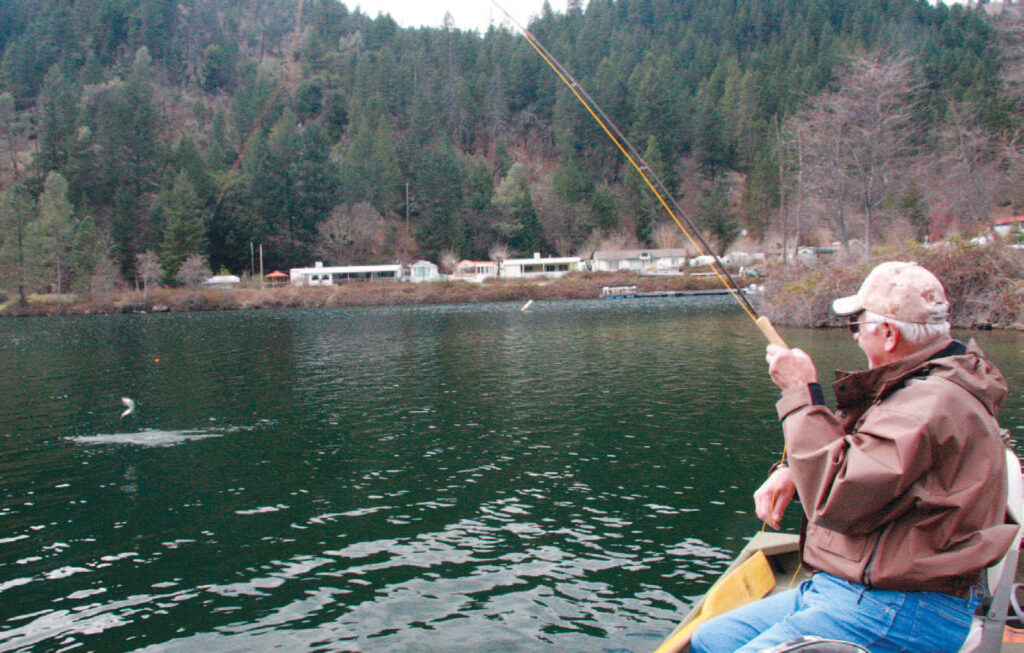
The fishing is not easy — anything but — and that’s the beauty of it. It’s all about stealth. This is about as close to spring creek fishing as you can get on a lake. Lengthen your leaders to at least 12 feet and tie on a 6X or even 7X tippet. You are likely to see sporadically rising fish all day long, but deducing exactly what they are focused on and where they are going requires time spent in observation.
Yes, they are usually taking Callibaetis mayflies, but not always. It might be damselflies or even flying ants that are getting the attention of the fish. On top of that, even when they are focused on the Callibaetis, you have to decide if they are taking emergers, duns, spinners or one winged female spinners with blue eyes whose sign happens to be Sagittarius. To me, this is some of the most intriguing fishing of all. When conditions are right, it’s as challenging a visual show as you could possibly desire.
Thanks to the gin-clear water, you can often see and target cruising fish. From a boat, if you have to stand in order to cast, sit down as soon afterward as you can. Fish can easily see you standing there, and they will automatically move out another 15 feet. Try to anticipate where each cruising fish is headed, then lay your cast down as gently as you can. Robert Traver, in his classic Trout Madness, beautifully describes the kind of presentation you have to make: “The cast itself was indecently easy and, finally releasing it, the little Adams sped out on its quest, hung poised in mid-air for an instant, and then settled sleepily on the water like a thistle, uncurling before the leader like the languid outward folding of a ballerina’s arm.” If you can’t exactly pull that off, at least try not to make your casts seem like some delinquent kid is throwing rocks at the fish. Ideally, you should give your dry fly a dusting of powdered desiccant every few casts to make it float higher and help you see it. When you’re having trouble seeing your fly, it sometimes helps to put your head closer to the surface of the water.
After you make a delicate cast, the cat-and-mouse game begins. Sometimes trout will snub your dry fly by eating nothing but naturals in the vicinity, conspicuously ignoring your offering. This is a great time to dig deep for hidden reserves of patience, breathe deeply, fall into a Zen-like state of meditation, or just say The hell with it and break out the depth charges. When a fish does finally grab your fly, try to resist the urge to set the hook as if you are marlin fishing.
Good Callibaetis emergers include Mercer’s Missing Link (an all-around great pattern), Harrop’s Last Chance Cripple, Mercer’s Poxyback Emerger, and of course the Adams, plus Haystacks, Paraduns and most Callibaetis spinner patterns, all in sizes 12 to 18. During the summer, it’s important to have a good selection in several different sizes of flies that imitate all of the Callibaetis life stages. On some level, I cannot help but think this is madness, brought on by the sometimes crazy, idiosyncratic nature of selective trout. In other words, it is the essence of fly fishing.
Watch the rise forms carefully to discern whether the fish are taking flies on the surface or just under it. If there is no telltale bubble after a rise, tie on an emerger. If the rises seem slow and lacking in urgency, this might be a clue the fish are taking spinners. Part of the fun of this fishing is dusting off all the skills you have and trying to stay one step ahead of the fish. Good luck with that.
Unorthodox Hail Mary
The fall is a lot like the spring, but the fishing is tougher. Autumn is a time of transition between the big Callibaetis hatch of the warmer months and the midge fishing of the winter. The flies you need to use are small, both Callibaetis nymphs and midge patterns, and the great cycle of food available to the trout seems to be at an annual low ebb. As the weather and the water cool, the metabolisms of the fish slow down, and it may seem as if they’ve abandoned the reservoir for their annual vacation in Maui or decided to go on a diet and get used to eating less. However, the sheer numbers of trout in Lewiston can work in your favor. One is bound to hit your fly sooner or later.
The most frustrating days are the ones that are warm and sunny, as if it were June. On days when everything seems right, except there seem to be no fish in the reservoir, it’s time to get creative. I’ve had success trying all sorts of unorthodox approaches. One Hail Mary ploy I tried in a moment of desperation is worth mentioning. Try tossing out a size 14 burnt orange soft hackle and slooowly stripping it back. I’m guessing it might look like a scud to the fish, but confirmation of this notion has not been forthcoming. The point is, it often works. I can think of many less appealing things to do than sit in a boat in a pretty place and experiment with crazy ways to catch trout.
Something’s Fishy
Lewiston gets its Shasta-strain rainbow trout from the Darrah Springs fish hatchery, and they are all triploid fish, meaning that they cannot reproduce. Unlike some triploids, the Lewiston fish do not typically grow to ginormous proportions, but they are solid trout, especially for hatchery fish.
There is also a “Net Pen” program at Lewiston Lake sponsored by Kokanee Power, the U.S. Forest Service, and the California Department of Fish and Wildlife in which some trout are kept in nets and fed with the intention of growing them really large before being released.
Though the CDFW politely refuses to say exactly how many trout are stocked in Lewiston annually, they are willing to admit that there are many, and the numbers were increased by 25 percent two years ago.
There are also both wild brown trout and kokanee salmon in Lewiston, although I haven’t caught either of them in a number of years. Anglers targeting these species usually focus on the lower, deeper parts of the reservoir, too deep for fly fishing.
One of the things that makes me a dumber angler than usual at Lewiston is that it is a terrific place to watch birds. Three pairs of bald eagles are currently nesting there, but eagles also move around to feed. You might also see eagles from Trinity Lake or nearby (for an eagle) Shasta Lake feeding at Lewiston. Together, these eagles constitute about 20 percent of all the nesting bald eagles in California.
I’ve been fishing Lewiston Lake for a lot of years. Despite sometimes being distracted into inattention by the surroundings, and despite whatever the temperament of the fish may be on any particular day, there is always a pleasant sense of familiarity in fishing it again. Many dramas have unfolded there for me, battles both won and lost, memories made. If a person can become part of a place, Lewiston Lake makes me hope that a place can also become a part of a person.



